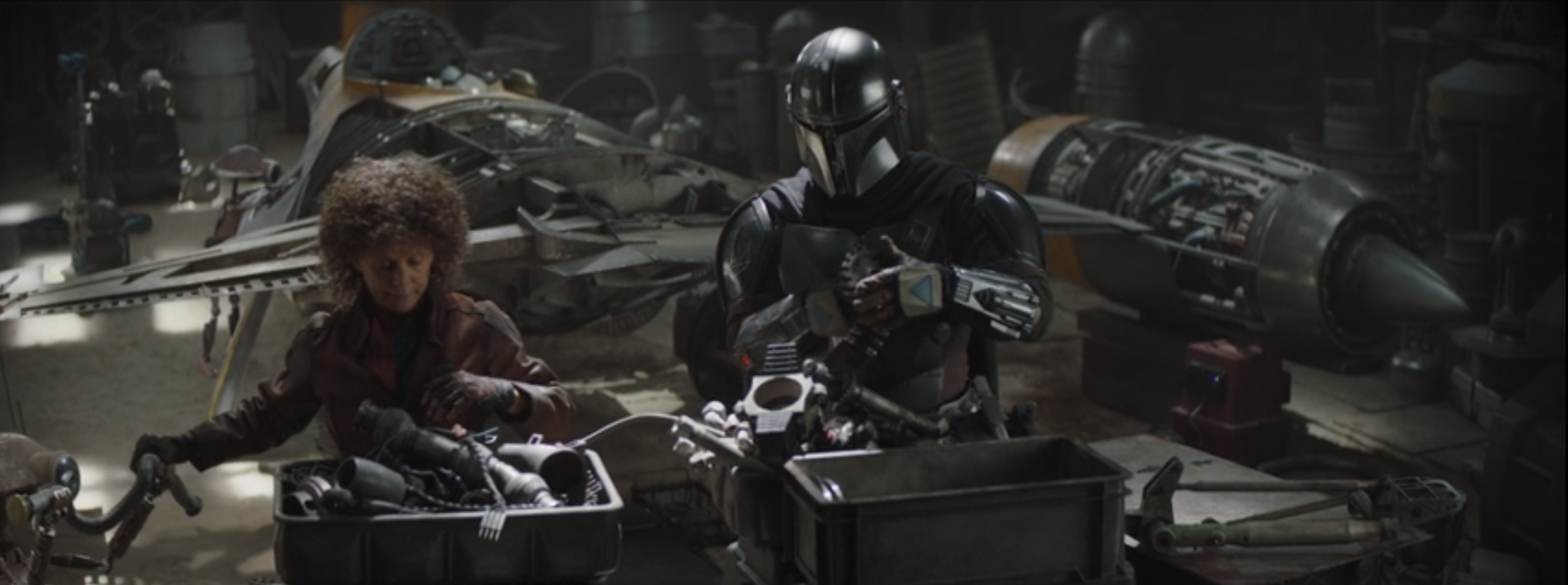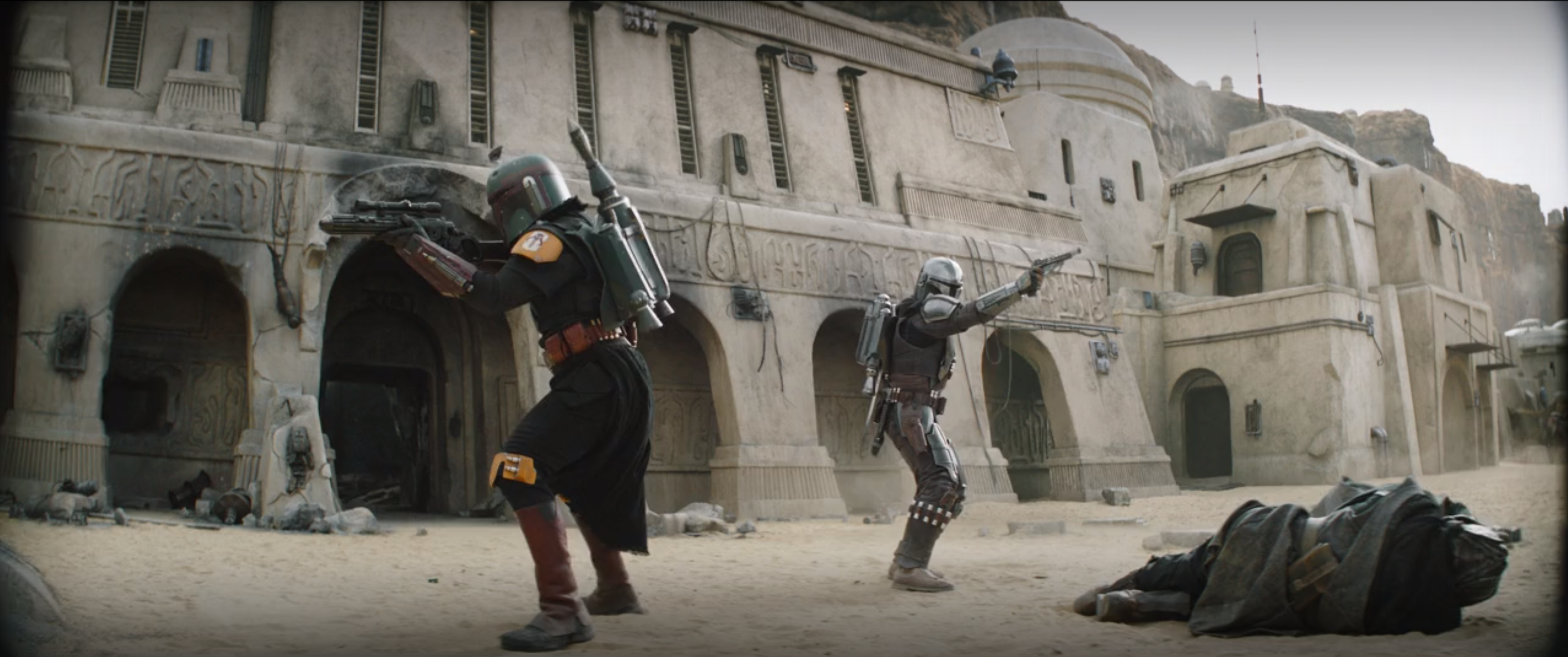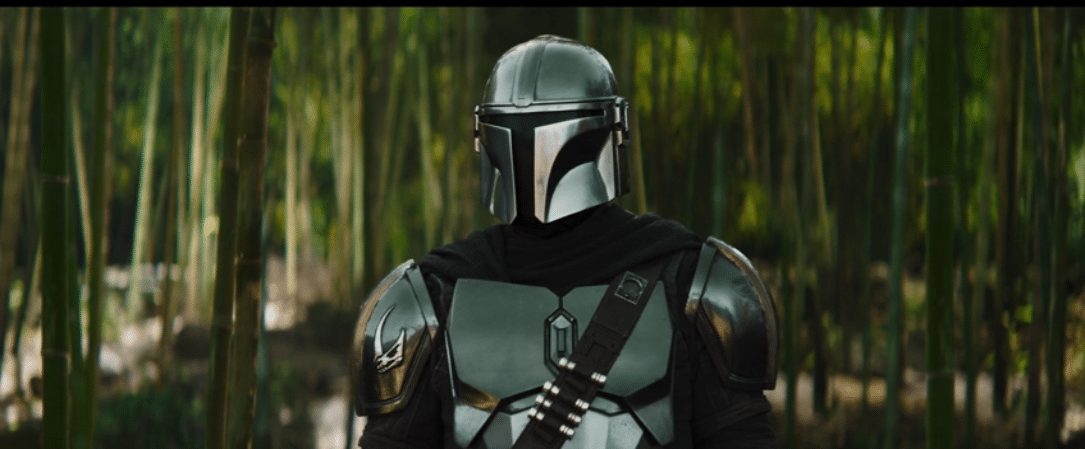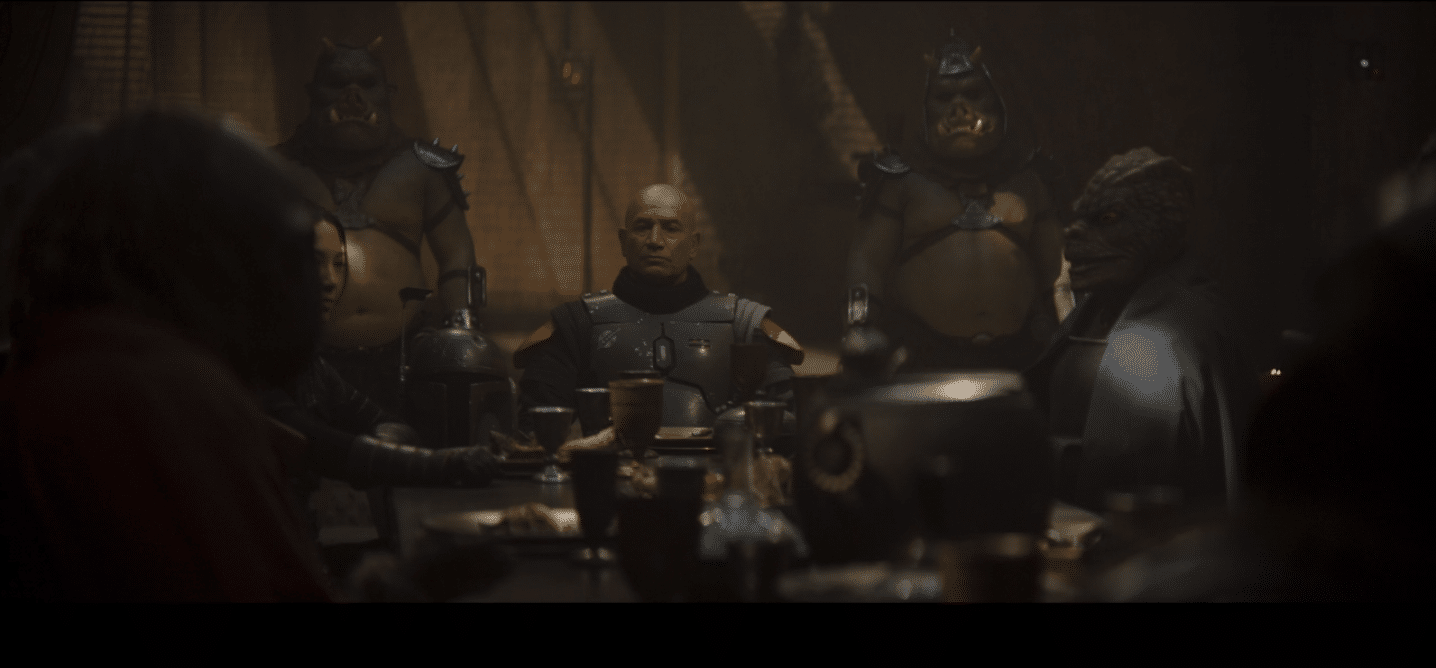The Book of Boba Fett takes a narrative detour to check in with an old friend, as the Mandalorian returns and meets some old friends(?), gets a new ship, and is offered a job in “Return of the Mandalorian”, written by Jon Favreau and directed by Bryce Dallas Howard.
Austin Gorton: Mark, welcome back to The Book of Boba Fett The Mandalorian coverage! This week’s episode featured the surprise (to me, I dunno, maybe the internet spoiled this) return of everyone’s favorite Grogu-loving, Darksaber-wielding Mandalorian, Din Djarin!
Mark Turetsky: Evidently the musical sting at the end of episode 4 was The Mandalorian’s theme. I didn’t notice it personally, but yes, this was definitely a straight-up episode of The Mandalorian. Given what we know about the secrecy around filming Star Wars TV projects, I wonder if the cast even knew that this wasn’t an episode of Mando season 3 as they were filming.
Austin: Good point on the secrecy, especially given we know at least some of the cast and crew showed for work on Book of Boba Fett thinking it was Mandalorian Season 3. This episode probably doesn’t help the confusion!
Mando’s Family Reunion

Mark: This episode begins like an early season 1 episode of The Mandalorian. He collects a bounty, then seeks out his fellow Mandalorians and gets some beskar equipment made. There’s a slight difference, in that he’s collecting the bounty in order to find where his people are hidden (and his employer insisting he sit down and have dinner with her is pure boundary-ignoring boss, right there), but it plays out in much the same way. I don’t know about you, but I found something comforting in seeing the Armorer and Paz Vizsla again.
Austin: There was definitely a feeling of “comfortable surroundings” all throughout this first act: the bounty hunting, the use of his particular “I’m taking you alive or dead, your choice” line, the return of the “Covert” from season 1, it’s the same kind of “going home” feeling you get at the start of a new season of a TV show. While Mando is initially welcomed back to his old family, his mission to return Grogu to his people complete, things quickly go south. Mando wants to maintain a relationship with Grogu even though he’s given up full custody, and his “family” discovers he’s wielding the Darksaber – and not wielding it all that well, either. This leads to a history lesson and a duel. Thoughts on either?
Mark: The flashback to the destruction of Mandalore was pretty intense stuff, with TIE Bombers nuking the planet and K2-style droids recreating the opening scenes of Terminator movies. We’ve got the Empire committing a straight-up genocide here. I know they destroy Alderaan in Star Wars, but this one seems much less impersonal. I hesitate to compare real-world politics to stories about space knights and wizards, but it’s worth noting that after the Holocaust, certain sects of Judaism recommitted themselves to a more zealous practice of their religion, isolating themselves from a sinful world, while some individuals lost faith altogether. I can’t help but see some parallels here, in the Mandalorian diaspora.
Austin: Those parallels are definitely there (I mean, how is “The Night of a Thousands Tears” NOT an invocation of Kristallnacht/the Night of Broken Glass?), and like the season’s earlier depictions of Native Tatooiner culture, it raises some questions about who can and should tell those kinds of stories.
In-universe, at least, the zealotry of this particular sect of Mandalorians ultimately leads to Mando’s exile. He is forced to admit he’s removed his helmet in the presence of others, thereby violating one of their core principles. Putting aside the fact that he did so only out of necessity and not for, like, fun reasons, this interrogation seemed to come out of nowhere. After Paz Viszla challenges Mando for the Darksaber (and loses), the Armorer randomly brings up this helmet business. Was she just trying to help Viszla save face, so to speak? Or separate the group from the Darksaber business now that they wouldn’t control it? Or am I missing something here?
Mark: My read on it is that it’s part of the ritual of the duel. The duel is over, now they’ve all got to be good, happy Mandalorians, which requires a re-commitment to their oaths. It’s like, “okay, you lost, but you lost to a Mandalorian, and we’re all friends here, right?” I don’t think she expected Djarin to have betrayed his oaths, otherwise I don’t think she would have forged the chain mail for Grogu (and tied it up in such a way that the handkerchief looks like Grogu’s head!). She was happy to have him go and get Grogu back as a foundling in their covert before the whole exile business.
But back to the Darksaber: it isn’t cooperating with Djarin at all, is it? He injures himself on it in the cold open, he can’t use it effectively in his duel, and even during training with the Armorer, she tells him he’s fighting it. There’s a lot of extended canon stuff about Kyber crystals having spirits (not to mention a ton of D&D stuff about sentient weapons), and it seems like this might be leading toward an on-screen acknowledgement of that.
Austin: Definitely. I think it also probably has something to do with the weapon having been forged by a Mandalorian who was also a Jedi, and the fact that Mando’s best bud is a (probable) clone of a super-powerful Jedi, making Mando uniquely situated amongst the Mandalorians of this time to reconcile those two sides of the weapon. Right now, he’s all Mandalorian, and so it’s fighting him. I did love him injuring himself while using it, just because it seems like that kind of thing should happen ALL THE TIME with neophyte Jedi or anyone untrained using a lightsaber (yes, I know, padawans use low-powered blades in training, don’t @ me).
Where’s Grogu?

Austin: Having been exposed as an apostate and with his options for atonement limited by the current state of Mandalore, Din takes leaves of the covert with his usual stoicism, then boards Space Delta for a flight to Tatooine.
Mark: Just imagine they’ve called your boarding group, you step onto the plane and your aisle-mate is a fully armored knight. It’s kinda wild. But such is Star Wars.
But even before he gets onto the transport, he has this moment with a security droid (and unlike most security droids in media, this one’s just a TSA-style, “I’m just doing my job here, man” working schlub). The droid tells him to relinquish his weapons. He briefly tries to argue a religious exemption as we saw in season 1 of Mandalorian. But he lets it go. He’s already been declared an apostate, so he’s going through this secular crisis: he’s been kicked out of the sect that cares about this, why not just hand over his weapons? And then on the transport, he meets an adorable Rhodian child in the seat in front of him. It’s such a commercial travel moment: I’ve had that happen, I’m sure you have, where someone else’s kid is curious about you and they look over the back of their seat and want to interact.
But of course, it’s a small green child. Grogu has such a presence in absence in this episode. He’s mentioned a few times, but even when he’s not on screen, you can’t help but ask,

Austin: It’s truly the question all our hearts are asking.
After Mando lands on Tatooine, which continues to do a masterful job of belying Luke’s assertion that it was a poorly-traveled backwater dump planet, we learn his old friend, the always delightful mechanic Peli and her coterie of droids, has landed him a sweet new ride in the form of a banged up old Naboo Starfighter. A couple montages later, Mando celebrates his recent divorce from his clan in the best tradition of dads having a midlife crisis: by taking his hot new sports car for a spin. Between the ship itself and Mando’s subsequent race through Beggar’s Canyon, this episode channeled some big Episode I energy; good, bad, or indifferent?
Mark: I’m going to sound like a caricature of someone of my generation when I say that I’m not a fan of the prequels. That said, it’s undeniable that the design work done in them is just superb, and the ship is a good looking ship. I like that they remove the yellow paint and give it that brushed steel look that goes so well with the Beskar armor.
As for Beggar’s Canyon, I spent my share of time playing Rebel Assault back in the day, so I know it well. It does smack of a certain tightrope act, where every throwaway line from the original trilogy needs to be pointed to and venerated somehow, without it just becoming empty fan service. It’s kind of a quasi-religious act of nerd fealty. But when on Tatooine, do as the Tatooiners do, I guess.
Just as a matter of practicality, did we ever see a Royal Naboo fighter crash on Tatooine in the prequels? If not, I sense a comic book one shot to explain it.
Austin: As far as I can recall, we did not, so be sure to check out ComicsXF’s review of Star Wars: The Adventures of Ric Olie #1 in 3-6 months!
I think calling myself a “fan” of the Prequels goes a little too far, but I’m definitely more forgiving of them than most fans of my generation (the old one). But for all their problems (and Episode I is, by far, the worst of the bunch, feel free to @ me, I love arguing about the Prequels), they exist, and so I like it when current Star Wars stuff acknowledges their existence. Especially when they do it like this, by cherry picking the good stuff to callback (like the cool-ass retro design of those Naboo Starfighters). I do wonder though, like a dad eschewing a cool hot rod for a sensible minivan, how well this new ship is going to fit Mando’s lifestyle. Where does he store his gear, let alone a prospective bounty, to say nothing of where exactly Grogu is supposed to sit for extended periods of time. But the whole sequence of repairing and testing the ship is, nevertheless, quite “wizard.”
Mark: And the New Republic traffic cops, err… the Rangers of the New Republic? pull Mando over for flying too close to a commercial ship. That’s some thin pretense for pulling him over. I mean, I guess it’s a fighter, so maybe they have a point (though just about every ship in the galaxy seems to be armed). And yeah, it seems like the wrong ship for his line of work, but I’m sure he’ll make it work somehow without the Falcon Crest, err, the Razorbill… whatever that old ship was called.
Din vs. Boba

Austin: Backdoor pilots (in which an episode on an ongoing series is used to set up a potential spinoff) and crossover episodes (in which characters from two different shows interact with each other in a shared episode) have long been staples of modern television. Yet this episode is something different, more like a “cul-de-sac episode” or an episodic amuse bouche for a series on hiatus. For the most part, I’ve been finding The Book of Boba Fett pleasantly enjoyable but not terribly exciting, though I remain cautiously optimistic about where it’s going. Yet, it probably doesn’t speak well of the series that its best episode yet – at least, its most entertaining – is one in which the title character cedes ground to the star of the show off which this series is ostensibly spinning. Does this episode say anything to you about the state of Book of Boba Fett, or are you just happy to have seen Mando again and are now eager to get back to the Boba narrative?
Mark: It’s definitely a strange move to make, to plop an episode of the wildly successful parent series right in there as they approach the climax of the spin-off. I also felt that it was the strongest episode so far. And that’s a weird thing, right? Five years ago, we hadn’t even heard of Din Djarin, and Boba Fett was this fetishized figure in the Star Wars canon (and Legends!). And now here we are, enjoying the official Boba Fett TV show enough, but we’re thrilled to cut away from his story to check back in with Djarin. Maybe because I think Book of Boba Fett seems like it’s trying to coast on that Boba Fett reputation without showing us why he might be a better crime boss than anyone else. Is he meant to be naive? Is he meant to be smart? Is he playing 4-dimensional chess? Or is Fennec Shand just slightly more competent than he is? I really don’t know at this point.
Austin: That’s a really good point – it’s not that we necessarily like Din Djarin more, but we know him better – at least, better than this iteration of Boba Fett. Which makes the decision to swerve here into an all-Mando episode all the more questionable: as you say, the Boba Fett of this series is still largely a cipher. We now have some general sense of why he’s doing what he’s doing, but we still don’t have a good sense of whether he’s supposed to be washed up or biding his time or something else entirely. Or, really, why we should even *care* why Boba’s doing what he’s doing. Sure, he wants to be his own boss, we can all relate to that, but why do we care that he’s being his own boss on Tatooine, choosing to fight this particular fight?
Mando’s presence is invigorating just because we know where we stand with him – he wants to go hot rodding in his cool new car and hang out with his little green buddy. Somewhere along the way, maybe, he’ll reconcile this whole Darksaber business and his relationship to Mandalore culture. Meanwhile, over halfway into The Book of Boba Fett, its title character remains largely an enigma, and yet despite that, it still chooses to sideline him for a third of its remaining run time. This episode is a blast, but that’s definitely not wizard.
Force Facts
- Episode title: “Return of the Mandalorian” (or is it “Return of The Mandalorian?”)
- The client in the opening of the episode is an Ishi Tib, one of the less-frequently-seen Original Trilogy aliens (they first appeared in Jabba’s palace in Return of the Jedi).
- The long cooling rod thing the Jawa brings Mando is the same piece of equipment as the thing Han uses to try and keep the walls of the trash compactor apart in A New Hope.
- This episode seems to suggest that “Razor Crest” is the model of Mando’s old ship, and not it’s name (like Boba Fett’s Firespray nee Slave I).
- Also, there’s a sense here that the Pyke presence on Tatooine is a relatively new development, and not something that existed on Tatooine during the OT that was simply never mentioned (ie they are reacting to the void left in the wake of Jabba’s death and Bib Fortuna’s subsequent ineptitude).
- “Don’t worry about the shape and size. Just get the parts you want with the specs you need and I’m gonna make it work, all right? I dated a Jawa. I know what I’m doing.” Peli Motto says love is love!
- Also, she informs us that Jawas are apparently quite furry under those robes.
- Mando’s old friend Captain Teva, who helped bail him and Frog Lady out in Mandalorian Season 2, is one of those New Republic pilots. The other is played by Max Lloyd-Jones, the actor who served as the body for the digitally-altered Luke in that season’s final episode.
- That space station is another example of why this episode stood out: it’s arguably the most visually interesting thing we’ve seen in the series thus far (aside from maybe the image of the Sarlaac trying to eat Boba’s ship, and even then, the image was clouded by the question of what the hell Boba was even doing there). It seems to be a Banks’ Orbital, not to be confused with a Ringworld. Orbitals are a more efficient use of matter than planets, and simulate their gravity by rotating over the course of a standard day. The ones Banks wrote about are much, much bigger though.







